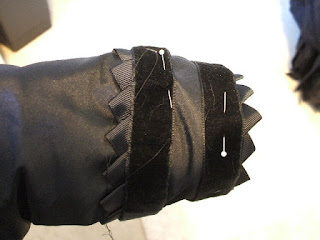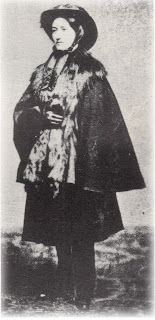February
2-3, 2013
A year ago
in 2012 just after the last Riverside (CA) Dickens Festival fashion show, I
kept thinking about doing more on mourning dress styles and suggested to our
coordinator about doing them the following year. After seeing a presentation at
Costume College on Dressing the Silhouette which showed ladies dress from the
inside out from 1800-1910, I came up with the idea of doing something similar
but expanding on it. I thought a solid black silhouette would make the changing
fashions really stand out. And we could include some education on mourning
customs.
This is our
mourning fashion timeline at Dickens last weekend, starting on the right- 1810-Lisa Klassen-Barnes, 1820- Cat
Frazier(absent), 1830- Gina Lovin, 1840- Michele Peoples (worn by Pamela
Swank-Yates), 1850- Mary Drobnis (dress
by me), 1860- Shelley Peters, 1870- Kathy Loftman (dress by Arlene), 1880- Me,
1890-Tonya Clevenger (absent), 1901- Arlene Terrell, 1910- Cindy Piselli.

I had already
been talking to Shelley Peters for the last couple years about us doing a
couple more gowns, since she portrays the Widow Peters already. I contacted a
couple other ladies who had been in the previous shows and a few others, and
asked if any of them would be interested in committing to making a correct
mourning gown for a specific time period. I chose the dates of 1810-1910 to
give each model a decade to cover. I didn’t have much problem filling most of
the spots but gave them all the opportunity to change their dates among
themselves, which we did a couple times. They each had to do some research of
what was appropriate for the time period, both in the dress style and the
mourning customs. Most of the customs were similar with a few variances, like when
white was still worn with black in the earlier decades. It would also encompass
first and second year mourning if they chose to, and different levels of
economy and society. They had a year to play around with their design and
construct it. One of them had hers made for her by one of the other models; one
wore my 1850s mourning gown, and one gown was worn by another model we brought
in at the last minute. We lost a couple ladies to jobs, illness and injuries.
Since my
favorite decade is the bustle, I chose 1880, specifically 1886, as my decade.
I already
had the skirt made so my focus was on the bodice, bustle overskirt, and hat. I
also had a muslin for TV’s 463 French Vest bodice, and used black velvet as the
vest insert. I used my black faux-silk
taffeta and purchased a big bag of black velvet covered buttons to close the
front of the bodice from Trim 2000Plus in the Garment District.. My first idea for
the bodice was to make some pleated trim to go along the edges of the vest but
after seeing some saw-tooth trim a friend made, I decided to try my hand at
making that. And I failed. Then I remembered I’d purchased some black grosgrain
saw-tooth trim from the Garment District in my stash. I had 10 yards so I could
use as much as I liked. I basted it down the sides between the velvet insert
and the taffeta side panels so it would stay in position when I machine-sewed
it.

I repeated
the saw-tooth trim with two rows on the sleeves with one row under the sleeve
edge, and another about 4 inches up from the edge. I finished the top of both
with a one inch wide velvet ribbon that I slipstitched on. I used four of the
velvet covered buttons and sewed those evenly between the two bands. Once I put
the collar on, I hand-stitched some more velvet ribbon around it.
The pattern
for the overskirt, TV 374 is an asymmetrical and splits open on the side front.
It has three different types of pleats on it with pleats on one side that drape
across the front to the other side, and a group of pleats above it on that side
seam. This photo shows the front pleats to the side but got a little wrinkled
being carried to the fashion show.
Then a group
of burnoose pleats in the back create the bustle. Burnoose pleats are like a
hood on a coat that creates a poof. I think. I tried doing them three times
before I got them to poof. I still don’t think they’re right but they seem to
work. Although I noticed in one photo one of them had turned the wrong way and
just looked like a point. But they really are cute little poofs. This photo
shows them gathered together, and where the white pin heads are were attached
to the waistband after they’re turned inside out to poof.
On
the side opening of the front, I sewed more of the saw-tooth trim all the way
down both sides and partly under the bottoms until they didn’t show. The fabric
curves under there so you wouldn’t see it anyhow.
My
accessories were a postman-style hat my friend Cat Frazier made for me from
scratch, using buckram covered with taffeta and trimmed with a black feather,
ribbon, and a black glass round brooch I’d found for 25 cents. She also made me
a taffeta and velvet drawstring bag to go with it. I stitched a black ribbon to
the edges of a white linen hankie, and wore black cotton gloves. My mourning brooch
was an antique jet oval I bought on ebay from Norway; in fact from the town my
grandmother came from. It has a small window in the back to hold a lock of
hair. I bought the reproduction earrings
from a shop at the San Francisco Dickens Faire last December.
Here are
some candid photos of me while walking in the Characters Parade after the show
on the streets.
Prior to our
coming onto the stage, our coordinator, Nancy Smith, invited me out to
introduce me. This sent a few tingles down my back hearing it. Good ones.
“ONE
OF THE THINGS I TRULY ENJOY ABOUT BEING INVOLVED IN THE HISTORICAL COSTUMING
SCENE IN SOUTHERN CALIFORNIA IS THE OPPORTUNITY TO MEET SO MANY TALENTED
LADIES. VAL IS DEFINITELY IN THAT CATEGORY. SHE IS A PAST PRESIDENT OF THE SAN
DIEGO COSTUME GUILD AND A MEMBER OF COSTUMER’S GUILD WEST. SHE HAS DONE
PRESENTATIONS AT MUSEUMS AND AT COSTUME COLLEGE, MOST RECENTLY BEING HER TALK
ON AMELIA BLOOMER AND REFORM IN WOMEN’S DRESS. SHE HAD ASKED ME LAST YEAR IF I
WANTED TO DO A SEGMENT ON MOURNING FOR THIS YEAR’S FASHION SHOW, AND HAS BEEN
PREPARING FOR THIS FOR MONTHS. I AM THRILLED AND HONORED TO BRING TO YOU ONE
HUNDRED YEARS OF MOURNING FASHION.”
***********************
For photos I took backstage of the fashion show while we were getting ready, please go to my album here.
http://www.pbase.com/cinnamonhrts/riverside_dickens_festival_2013


.jpg)








































